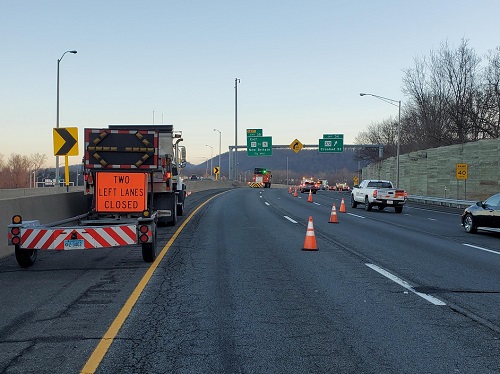The morning and afternoon commutes along Interstate 95 in southwest Connecticut will still be a little congested, but maybe a little quieter, thanks to “quiet pavement” the Connecticut Department of Transportation plans to install as part of a road resurfacing project.
[Above photo by Connecticut DOT]
The three-lane (each way) 6.7-mile stretch of I-95 from the New York state line to Stamford carries about 135,000 vehicles a day, much of which is commuter traffic to and from New York City. A Connecticut DOT project to repave the interstate will include a specialty asphalt mix designed to absorb more noise than concrete and last longer than traditional asphalt.
The impetus behind using this “quiet pavement” derived from feedback from people who live and work in the area; they asked the agency to do something about the interstate noise. Some residents had even created a group, Neighborhood Citizens Against I-95 Noise, to push Connecticut DOT to undertake some noise abatement measures.
The department got the message, explained Garrett Eucalitto, Connecticut DOT’s commissioner.
“We seek out resident, business, and stakeholder input when any project is undertaken,” explained Eucalitto, who also serves as the 2023-2024 vice president for the American Association of State Highway and Transportation Officials. “These groups know the needs of the area, and their insights are valued and appreciated.”
While quiet pavement is not an official Federal Highway Administration noise mitigation method, Eucalitto said the asphalt mix is “expected to reduce highway noise by two to three decibels.”
Andi Karica, resident engineer on this Connecticut DOT paving project, said crews will begin removing existing pavement this spring and replace it with a one-inch Binder Rich Intermediate Course topped with two inches of Stone Matrix Asphalt.
“It’s a completely different mix design that takes different ratios of binder and stone aggregate,” Karica said. “It’s a sticky mix, a little harder to work with, but it should be more durable and translate to less noise.”
The Stone Matrix Asphalt is new to Connecticut DOT, but different forms of it have been around for many years. Most of the states that have used it – Arizona, California, Texas, Georgia, and Florida – have warmer climates, and many results show a two decibel reduction in noise.
“This type of asphalt has never been used before in Connecticut, so the Stamford and Greenwich Project will be a pilot program to ensure the longevity and durability of the materials,” Eucalitto said. “We look forward to seeing the results as we continue to deliver projects that improve safety and reliability for all roadway users.”
As the paving project gets started this spring, Connecticut DOT will continue managing a Planning and Environment Linkages study along I-95 that is looking at a broader range of environmental, economic, mobility, and safety issues along the corridor.
The study, which began in June 2023 and is scheduled to be completed in December 2025, will rely heavily on community input, and is designed to help the department develop specific projects.

